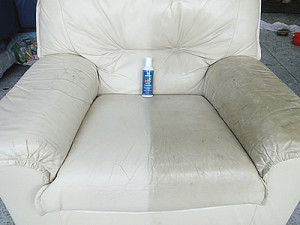Leather Care Guide – Caring for Your Leather
Leather is an elegant and robust furniture material. Being a natural material it needs some basic knowledge to keep it in a good condition.
Always shake protector and conditioner before use
Simple and Effective
 A demonstration of the effects of Colourlock Leather Cleaner on a soiled leather chair.
A demonstration of the effects of Colourlock Leather Cleaner on a soiled leather chair.
Later Colourlock Leather Shield Protector was applied.
24-hours later Colourlock Fadegard was added to condition and moisturise the leather, protecting it from further fading and damage.
Cleaning
Clean the leather regularly (every three months) using Colourlock Leather Cleaner, concentrating on the arms, headrests and cushion areas. Pour the cleaner onto a clean white lint free cloth (an old sheet or pillow case is fine).You can also pour a little directly onto the leather, then using a circular motion gently wipe over the leather, avoiding over-wetting. Dry with towel if necessary. If your leather has more ingrained heavy soiling, use the cleaner in conjunction with a soft bristled (horse hair) brush, using a circular motion, to loosen the soiling from deep in the leather pores. Then wipe with a soft clean white towel to absorb and remove soiling.
(Do not use brush on two colour, antique or wypa leathers)
Watch video below on how to clean, condition and protect your leather lounge suite
See more instructional vidoes on our YouTube page
Protection
Always apply Colourlock Leather Shield Protector directly after cleaning.
Apply directly onto a lint free cloth and wipe over the leather surfaces, mainly concentrating on the seat tops, pipeing, arms and headrest areas on furniture.
In cars the front seats and entry areas/bolster panels require the most attention (high contact areas). This will protect against dye transfer and friction damage.
If you have just purchased white or light coloured leather, apply Colourlock Leather Shield Protector as soon as possible and then on on a monthly basis, especially on high wear areas, to protect against soiling and dye transfer.
For darker coloured leather use Colourlock Leather Shield Protector every three months, to prevent premature wear and discolouration.
Colourlock Leather Shield Protector has a permeable membrane that allows the leather to breathe – allowing air, water vapour and conditioning oils to penetrate.
Colourlock Leather Shield Protector places a nano- barrier on the leather surface, minimising dirt, soiling and dyes from transfering to the leather. This makes it easier to clean and gives a smooth silky feel.
If used regularly, this unique revolutionary product will significantly extend the life of your leather.
Conditioning
If Colourlock Leather Shield Protector has been applied, wait 24 hours before applying the Colourlock Fadegard Leather Conditioner.
The protector has been designed to allow the conditioner to penetrate through the permeable barrier leaving the protective coating in place.
Apply Colourlock Fadegard Leather Conditioner directly onto a lint free cloth and wipe over the leather surfaces using a circular motion. This product moisturizes, nourishes and feeds the leather, while protecting against harmful UV rays.
Condition leather regularly (every three months) using Colourlock Fadegard Leather Conditioner, (more often, if the leather furniture is exposed to high levels of sunlight).
Waxy or pull up leathers
Colourlock Elephant Leather Preserver is excellent for the removal of scratches or fingernail marks. Feeds, nourishes and revives faded colours and dyes.Good for nourishing and feeding waxy or pullup leather. Apply using a circular motion to aid penetration. (If too labour intensive use Fadegard Leather Conditioner.)
Note. With any care products, always test on an unseen area before use. All leathers are different – different hides, different tanners, different countries.
A safe rule is: LESS IS BETTER THAN MORE.
Facts about Leather Maintenance
Fact 1: The clear protective top coat must be protected from jeans studs, pockets and zips. They cause FRICTION DAMAGE to edges, seams and seats. Oils and fats (from the head and hands) often plasticise the protective coating and INCREASE friction damage.
Fact 2: The top coat must be protected from clothing dyes which can transfer (especially when damp) to the leather, resulting in permanent damage that only a professional can remove. In testing it was found oils and fats INCREASED dye penetration.
Fact 3: Leather should be conditioned on a minimum of three or four times a year to keep it soft and to prevent shrinkage and cracking.
How do you look after leather?
Observe the following points and your leather will give you years of enjoyment.
General Care Tips:
- Avoid placing your leather in direct sunlight. Consider getting your windows tinted to prevent sun damage or fading.
- If possible rotate the use of your furniture and cushions to avoid unbalanced wear and fading.
- Dust and vacuum your furniture regularly.
- Wipe off stains and spills immediately with a soft damp cloth.
- Never use nail varnish /remover, felt or ink pens, paints or solvents on leather.
- Avoid sharp objects. Pet claws, buckles and rings can scratch the leather surface.
- Never use general household cleaning products as they can be abrasive, breaking down the protective surface and cause cracking and shrinkage.
- To keep leather soft, avoid over-wetting. As with leather shoes, stiffening occurs with soaking.
- The colour on the surface is protected by the tanner’s Top Coat, a clear coating. It is matt or silk-glossy. Fats and oils can soak in and damage this clear coating
- Fats, oils and beeswax are for waterproofing and polishing shoes, saddles and outside equipment. NOT FOR TOP-COATED modern leather furniture.
